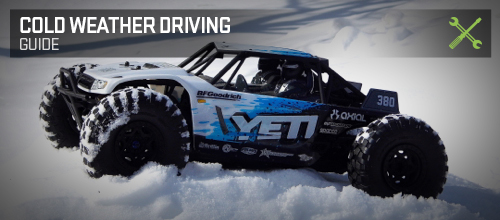Posted: 2/25/15

Even if you put all of your Axial Racing vehicles away for the winter, you may find the temptation to try to tackle some axle-deep snow or the urge to slide around on some slick ice too much to take. As such, you may find yourself charging batteries and bundling up in your snow gear before you know it. You know how to get yourself ready for the cold, but you may not know how to get your Axial rig ready for cold weather.
Word of caution: all the rules that apply to water apply to snow. If your electronics aren't protected for water, they aren't protected for snow. Also, water and snow damage isn't limited to electronics. Read this post to learn more about the damage water can cause here.
Snow can stick like glue. It collects in wheels and in the chassis. It will stick to the axles and the bottom of the chassis. It can fill the body. This snow can cause hardware to corrode. Axial uses high-quality hardware that has a protective finish, but between normal wear and moisture, the hardware can still rust. The solution is twofold. First, coating the bottom of the chassis and axles with WD-40 will both ease the amount of the snow that sticks and help prevent corrosion. There are other products similar to WD-40, but WD-40 is inexpensive and easy to find. The second part is a good cleaning. Drip drying under your work bench is not a good cleaning method. Remove the body and brush away the snow. Some cheap stiff bristled paint brushes work perfectly for this. A tooth brush also helps. Remove the wheels and wipe down the axles with some WD-40. Also wipe down any exposed metal hardware. This will prevent corrosion.
Batteries do not perform well in extreme temperatures. The key is to charge the packs fully and to keep them indoors until ready for use and to immediately remove them when done running. Dry the packs and keep them indoors. Keep in mind that temperatures can impact the voltage of a battery, so don't over drain a LiPo pack. Stop running well before your LiPo cutoff kicks in.
One of the best benefits of driving in the cold comes from driving on ice. If you have a Yeti and live in an area that has frozen water, you are in for a great driving lesson. First, make sure you have absolute confirmation that the ice is safe. Just because you've seen someone walk it doesn't mean the ice is safe. Get absolute confirmation. When you drive a fast vehicle like the Yeti on slick ice, you will quickly learn how to counter steer. This will make you an awesome driver. You also learn how to properly start and stop.
One of the most important things to know about cold weather driving is that plastic gets less flexible and more brittle as temperatures drop. Even the composite plastics used in Axial vehicles can be susceptible to damage in extremely cold temperatures. What may not cause any damage in warm temperatures could cause a parts failure when temperatures are cold. The solution is to drive more cautiously. Take fewer risks, drive a little slower and try to avoid collisions.